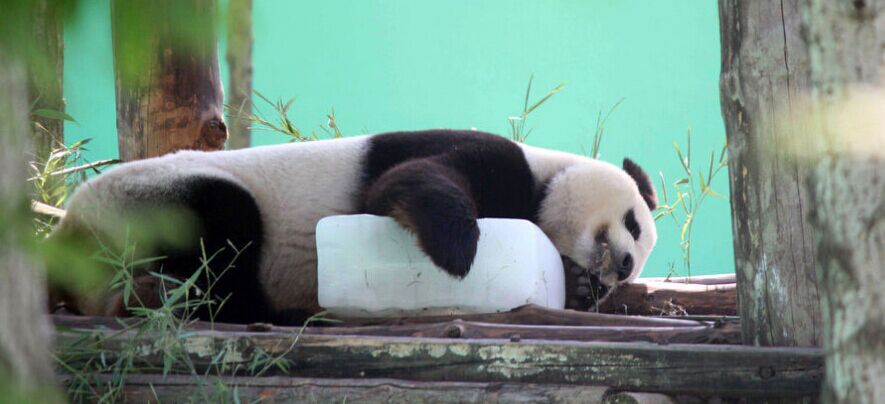In nearly June,10 months old panda Hu Niu was prepared to migrate up from their winter habitat to their summer habitat with her mother.Until then, Hu Niu lived in a Bashania fargesii forest, otherwise known as subalpine fir forests. Since her birth last August, the nursing cub has resided below 2,000m altitude in the mountains.
In late April of this yell Hu Niu and her mother migrated to a river valley in the lower mountains. Spring arrived and with it blossoming flowers and Banshaniafargesii bamboo shoots. These shoots are favorite among pandas,grow up to 20cm every day reaching as high as30cm-70cm and 2cm in diameter. At this time of the year, the shoots are fresh, delicious and rich in nutrition. By early June, Bashaniafargesii bamboo shoots have grown to 3m high and are too tough and woody to eat. When the temperature rises to 20 , the pandas have to stop and pant to regulate their body temperature. Mosquitoes irritate the pandas and also a reason that propels them to migrate from lower altitudes to higher ones in the summer.
Usually giant pandas reside in coniferous and broadleaf mixed forested areas above 2,200m and in dark coniferous forest of2,400m to 3,000m in elevation. There, except for some exposed rocks and gravel beaches sits a geomorphology that has survived since the Fourth Glacial Age on both sides of the ridge. Fargesia qinlingensis are native to the area and serve as the main food source for giant pandas during the summer months.
In the Qinling Mountains, summer is the best season for plant growth. In June, with an average temperature of 10 oC, it is cool on both the northern and southern slopes of the main ridge in the Qinling Mountains. By noon temperatures peak at wound 20 oC, and Fargesia qinlingensis begin sprouting new shoots. Pandas rely on the fresh and delicious bamboo shoots until August when they shift to subsisting on bamboo leaves.
Pandas remain in their summer habitat for approximately three to four months from June to mid-September. Except for pregnant mothers who move to dens in caves on slopes at around 1,800m to 2,000m above sea level in July or August, most pandas will not move to the Bashaniafargesii forest or below 2,000m until frost or snow arrives in early October. The temperature drops sharply in early September, causing the Fargesia qinlingensis leaves to lose moisture and turn grey summer, pandas tend to prefer the northern slope of the main ridge. Because there are fewer hours of light, the forest temperature on the northern slope is 2T lower d2an that on the southern slope at the same altitude.
Over the course of many years, researchers observed and recorded Feeding patterns in the areas pandas frequently used in summer months. It became apparent that the animals preferred arrow bamboo in the forest rather than the pure arrow bamboo found on the southern slope. They traverse the pure arrow bamboo forest to their favored area, seldom stopping to eat or rest. Fargesia qinlingnesis bamboo can be found dispersed in clusters throughout the dark coniferous forest, which is made up of Abiesfargesii and Abies chensiensis fir trees. The forest clearing between the bamboo dusters becomes a heavily used wildlife corridor.
Fargesia bamboo grows in clusters, forming dense foliage. The clusters found around the edges of the tightly packed vegetation get superior illumination and ventilation and increases the rate of those particular shoots wildlife residing within the thick bamboo forest have excellent protection h:ore predators and a sheltered habitat.
The size of the pandas summer habitat is 2096 less than their winter habitat. Due to it being a heavy used albeit small corridor pandas often cross paths. When a male panda meets a female, he often chases berm a attempt. Other pandas are often drawn in by their vocalizations. Most scientists expected that pandas would be in the courtship phase during summer months, but, after careful observation, they determined the male pandas often pursued females during this season.
Summer rain comes frequently in the Qinling Mountains. The low-lying areas between the north and south slopes provide drinking water for the giant panda and other wild animals. Giant pandas mostly drink water in the afternoon or evening.
Numerous other wild animals breed and take shelter from the sun in the same habitat. Every June or July golden gather on Qmling’s main ridge to mate. There are also Asiauc black bears, wild boars, badgers, gorals and various other wildlife. The Asiatic black bear and wild boll also feed on bamboo shoots, competing with the giant panda for food.
Investigators focused on migration research by tracking a pair of two years old female pandas welling GPS collars from 1991 to 1996. When in the summer habitat, the giant pandas tended to spread out to the northwest leaving their main territory This behavior is similar to humans cross-region marriage, showing that giant pandas are some way instinctively avoid inbreeding.


























































































